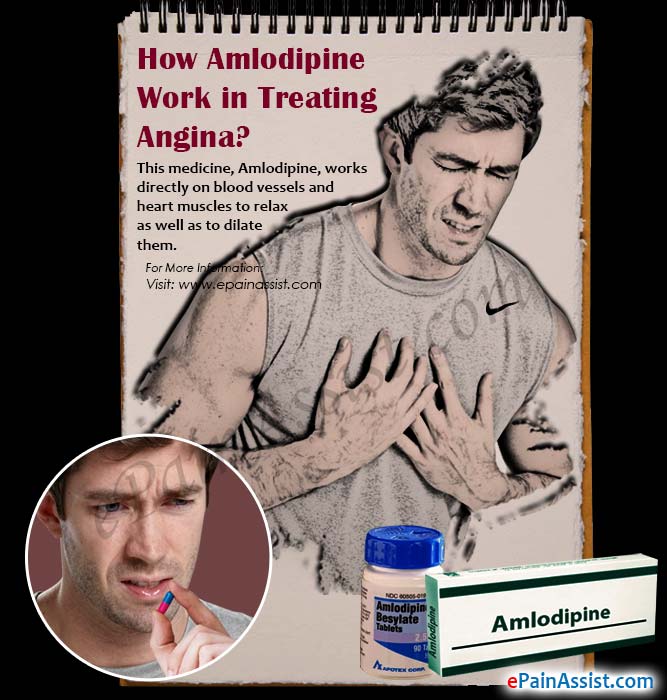How Amlodipine Work in Treating Angina?
This medicine, amlodipine, works directly on blood vessels and heart muscles to relax as well as to dilate them. It is also used to treat heart conditions such as angina and high blood pressure.
A calcium channel blocker which widens the flow of the blood in blood vessels by dilating them and improves blood flow is known as amlodipine. It is a medicine that can be used in treating chest pain, which is also known as angina as well as other conditions that have been caused by coronary artery disease.
This medicine can also treat high blood pressure (hypertension). If your blood pressure is lower, then it can result in a stroke or heart attack. Children who are at least 6 years old and adults can use amlodipine.
You should tell your doctor prior to taking amlodipine if you have congestive heart failure or liver disease. Drinking alcohol can escalate certain side effects of amlodipine. It can also further lower your blood pressure.
Continue to use amlodipine even if you feel well if you are being treated for high blood pressure, at times there may be no symptoms for high blood pressure. You may have to continue using blood pressure medication for the rest of your life.
Amlodipine is part of a complete program of treatment that consists of diet, weight control, exercise, and other medications. Follow your diet, exercise routines and medication very closely.
You should consult your doctor about all other heart or blood pressure medications you are taking. When you first start taking amlodipine or when your dose has been increased, your chest pain may become worse. Consult your doctor immediately, if your chest pain is severe or ongoing.
Avail of emergency medical help on noticing any signs of an allergic reaction to amlodipine: Difficulty breathing; hives; lips, swelling of your face, tongue, or throat. There may be rare cases when you first start taking amlodipine that your angina may get worse or you could have a heart attack. Call your doctor right away and seek emergency medical attention if you have symptoms such as: Pain spreading to your jaw or shoulder, chest pain or pressure, sweating and nausea.
Call your doctor at once if you have:
- A light-headed feeling, like you might pass out.
- Pounding heartbeats or fluttering in your chest;
- Severe drowsiness; or
- Swelling in your feet or ankles.
- Worsening chest pain.
Common Amlodipine Side Effects May Include:
- Dizziness;
- Feeling tired;
- Flushing (warmth, redness, or tingly feeling)
- Stomach pain, nausea.

How Effective is Amlodipine in Treating Angina?
Amlodipine is useful in effectively relieving angina-related symptoms and lowering blood pressure. It is suggested over other types of heart medications.
- The manufacturer says that you can take amlodipine with grapefruit juice.
- Be careful when going from sitting to standing since your blood pressure may drop.
- Let your doctor know if there are any signs of dizziness, tiredness, nausea, flushing, shortness of breath, indigestion, muscle rigidity or tremors, excessive weight gain, or edema.
- Dial 911 to report to an emergency department if facial swelling, wheezing, cough, chest tightness, or seizures occur suddenly.
The response and effectiveness of Amlodipine is good. It is between 6-12 hours that peak concentrations occur band this effect lasts for approximately 24 hours.
What is the Recommended Dosage of Amlodipine?
Conventional Dose for the Adults for Hypertension
Continuation Dose: 5 to 10 mg orally once a day.
Initial Dose: 5 mg orally once daily.
Maximum Dose: 10 mg/day.
Conventional Dose for the Adults for Angina Pectoris
Maximum Dose: 10 mg/day.
Continuation Dose: 5 to 10 mg orally once a day.
Usual Adult Dose for Coronary Artery Disease
Maximum Dose: 10 mg/day.
Continuation Dose: 5 to 10 mg orally once daily.
Conventional Geriatric Dose for Hypertension
Continuation Dose: 5 to 10 mg orally once a day.
Initial Dose: 5 mg orally once a day.
Maximum Dose: 10 mg/day.
Usual Geriatric Dose for Angina Pectoris
Continuation Dose: 5 to 10 mg orally once a day.
Initial Dose: 5 mg orally once a day.
Maximum Dose: 10 mg/day.
Usual Pediatric Dose for Hypertension
6 to 17 years: 2.5 to 5 mg per day.
Maximum Dose: 5 mg/day.
Safety & Side Effects of Amlodipine in Treating Angina
The use of amlodipine is safe as it is also recommended for children, but if your age is between 18 and 60 years, you are advised to not to take any other medication or have no other medical conditions, side effects you are more likely to experience include:
- Edema (swelling around the ankles) is the main side effect. Dizziness, shortness of breath, flushing, fast or irregular heart beat and wheezing has also been reported.
- It seems that it has no or little interaction with grapefruit or grapefruit products.
- Lower doses may be needed in patients with liver disease.
Conclusion
Amlodipine effectively helps to alleviate angina. It also lowers blood pressure. It can however result in edema in the feet.
